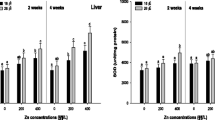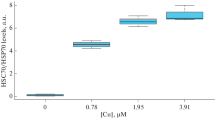Abstract
The effects of different salinity levels (28, 34 and 40‰) on functional responses of Chamelea gallina haemocytes were evaluated in a two part study dealing with modulations of immune parameters. This part (Part II) of the study was focused on the superoxide dismutase (SODs) activity and expression in haemocyte lysate and cell-free haemolymph. Results of this study established that the exposure of C. gallina specimens at 40‰ salinity provoked a decrease in Mn-SOD and Cu/Zn-SOD activities in haemocyte lysate suggesting a declining superoxide anion generation at the highest salinity tested. Expression of MnSOD was coherent with activity values, while Cu/ZnSOD showed two immunoreactive bands. The former corresponds to the cytosolic Cu/Zn-SOD (16 kDa) was not coherent with the enzyme activity and the second (28–30 kDa) probably attributed to EC-SOD. In cell-free haemolymph, Mn-SOD activity decrease and Cu/Zn-SOD activity increase at 40‰ were observed, likely due to EC-SOD contribution, strongly induced at the same salinity. After EC-SOD detection with two different antibody, we postulate that the EC-SOD like-protein band (29 kDa) may be constitute partly by EC-SOD and probably by Cu/Zn-SOD dimeric form not completely dissociated under reducing condition or a Cu/Zn-SOD degenerated but still recognized by antibody. The cell-free haemolymph increase of EC-SOD at high salinity values plays an important role in immune defence of C. gallina. According to the conclusion of Part I of this study, our data confirmed the destabilizing effect of 40‰ salinity on haemocyte functionality, while to 28‰ exposure, data don’t confirm its stressful action as instead stated by results of Part I. Further studies are necessary to clear up this discrepancy.






Similar content being viewed by others
References
Adema CM, Van der Knaap WPW, Sminia T (1991) Molluscan hemocyte-mediated cytotoxicity: the role of reactive oxygen intermediates. Rev Aquat Sci 4:201–223
Anderson RS (1994) Hemocyte-derived reactive oxygen intermediate production in four bivalve mollusks. Dev Comp Immunol 18:89–96
Anderson RS, Burreson EM, Paynter KT (1995) Defence responses of haemocytes withdrawn from Crassostrea virginica infected with Perkinsus marinus. J Invertebr Pathol 66:82–89
Annual Report (2001–2005), Struttura Oceanografica Daphne (ARPA) (2001) Regione Emilia-Romagna, Assessorato Agricoltura Ambiente e Sviluppo sostenibile. Studi e documentazione
Beckmann N, Morse MP, Moore CM (1992) Comparative study of phagocytosis in normal and diseased hemocytes of the bivalve mollusc Mya arenaria. J Invertebr Pathol 58:124–132
Bernardi Aubry F, Berton A Bastianini M, et al (2004) Phytoplankton succession in a coastal area of the NW Adriatic, over a 10 year sampling period (1990–1999). Cont Shelf Res 24:97–115
Campa-Cordova AI, Hernandez-Saavedra NY, De Phillippis R, Ascencio F (2002) Generation of superoxide anion and SOD activity in haemocytes and muscle of American white shrimp (Lipopenaeus vannamei) as a response to β-glucan and sulphated polysaccharide. Fish Shellfish Immunol 12(4):353–366
Chan P, Liao SS, Hsu CT, Lee YS, Brian T, Kuo JS, Cheng JT (1999) Superoxide dismutase gene expression and activity in the brain of spontaneously hypertensive rats and normotensive rats. Chin Med J 112(12):1119–11124
Cheng TC (1981) Bivalves. In: Ratcliff NA, Rowley AF (eds) Invertebrates blood cells I. Academic, London, pp 233–299
Cheng W, Juang FM, Chen JC (2004) The immune response of Taiwan abalone Haliotis diversicolor supertexta and its susceptibility to Vibrio parahaemolyticus at different salinity levels. Fish Shellfish Immunol 16:295–306
Chu FE, La Peyre JF (1993) Perkinsus marinus susceptibility and defense-related activities in eastern oysters Crassostrea virginica: temperature effects. Dis Aquat Org 16:223–234
Chu F LE, La Peyre JF, Burreson CS (1993). Perkinsus marinus infection and potential defence-related activities in easten oysters Crassostrea virginica: salinity effects. J Invertebr Pathol 62:226–232
Chu F LE, Hale RC (1994) Relationship between pollution and susceptibility to infectious disease in the eastern oyster, Crassostrea virginica. Mar Environ Res 38:243–256
Conte A, Ottaviani E (1995) Nitric oxide synthase activity in molluscan hemocytes. FEBS Lett 365(2–3):120–124
Crapo JD, McCord JM, Fridovich I (1978) Preparation and assay of superoxide dismutases. Meth Enzymol 53:382–393
Dikkeboom R, Van der Knaap WP, Meuleman EA, Sminia T (1985) A comparative study on the internal defence system of juvenile and adult Lymnaea stagnalis. Immunology 55(3):547–553
Downs CA, Fauth JE, Woodley CM (2001) Assessing the health of grass shrimp (Palaemonetes pugio) exposes to natural and anthropogenic stressors: a molecular biomarker system. Mar Biotechnol 3(4):380–397
Finkel T, Holbrook NJ (2000) Oxidants, oxidative stress and the biology of ageing. Nature 408:239–247
Fisher SW, Ford SE (1988) Flow cytometry: a tool for cell research in bivalve pathology. Am Fisheries Soc Spec Publ 18:286–291
Fridovich I (1995) Superoxide radical and superoxide dismutases. Annu Rev Biochem 64:97–112
Fridovich I (1982) Measuring the activity of superoxide dismutase: an embarrassment of riches. In: Oberlay LW (ed) Superoxide dismutase, vol I. CRC Press, Boca Raton, pp 69–77
Gagnaire B, Frouin H, Moreau K, Thomas-Guyon H, Tristan Renault T (2006) Effects of temperature and salinity on haemocytes activities of the Pacific oyster, Crassostrea gigas. Fish Shellfish Immunol 20:536–547
Galloway TS, Depledge MH (2001) Immunotoxicity in invertebrates: measurement and ecotoxicological relevance. Ecotoxicology 10(1):5–23
Halliwell B, Gutteridge JMC (2000) Antioxidant defences. In: Free radicals in biology and medicine, Oxford University Press Inc (Ed), New York
Iizuka S, Taniguchi N, Makita A (1984) Enzyme-linked immunosorbent assay for human manganese-containing superoxide dismutase and its content in lung cancer. J Natl Cancer Inst 72:1043–1049
Lacoste A, Malham SK, Cueff A, Poulet SA (2001) Stress and stress-induced neuroendocrine changes increase the susceptibility of juvenile oysters (Crassostrea gigas) to Vibrio splendidus. Appl Environ Microbiol 67:2304–2309
Gall G, Bachère E, Miahle E (1991) Chemiluminescence analysis of the activity of Pecten maximus hemocytes stimulated with zymosan and host-specific Rickettsiales-like organisms. Dis Aquat Org 11:181–186
Le Moullac G, Soyez C, Saulnier D, Ansquer D, Avarre JC, Levy P (1998) Effect of hypoxic stress on the immuneresponse and the resistance to vibriosis of the shrimp Penaeus stylirostris. Fish Shellfish Immunol 8:621–629
Lowry OH, Rosebrough NJ, Farr AL, Randall RJ (1951) Protein measurement with the Folin phenol reagent. J Biol Chem 193(1):265–275
Malham SK, Lacoste A, Gélébart F, Cueff A, Poulet SA (2003) Evidence for a direct link between stress and immunity in the mollusc Haliotis tubercolata. J Exp Zool 295A:136–144
Le Marklund SL (1982) Human copper-containing superoxide dismutase of high molecular weight. Proc Natl Acad Sci USA 79:7634–7638
Manduzio H, Monsinjon T, Rocher B, Leboulenger F, Galap C (2003) Characterization of an inducible isoform of the Cu/Zn superoxide dismutase in the blue mussel Mytilus edulis. Aquat Toxicol 64:73–83
Matozzo V, Monari M, Foschi J, Papi T, Cattani O, Marin MG (2005) Exposure to anoxia of the clam Chamelea gallina. I: effects on immune responses. J Exp Mar Biol Ecol 325:163–174
Matozzo V, Ballarin L, Pampanin DM, Marin MG (2001) Effects of copper and cadmium exposure on functional responses of hemocytes in the clam, Tapes philippinarum. Arch Environ Contam Toxicol 41(2):163–170
McCord JM, Fridovich I (1969) Superoxide dismutase: an enzymic function for erythrocuprein (hemocuprein). J Biol Chem 244(22):6049–6055
Monari M, Matozzo V, Foschi J, Marin MG, Cattani O (2005) Exposure to anoxia of the clam, Chamelea gallina II: modulation of superoxide dismutase activity and expression in haemocytes. J Exp Mar Biol Ecol 325:175–188
Monari M, Matozzo V, Foschi J, Cattani O, Serrazanetti GP, Marin MG (2007) Effects of high temperatures on functional responses of haemocytes in the clam Chamelea gallina. Fish Shellfish Immunol 22(1–2):98–114
Monari M, Cattani O, Serrazanetti GP, Selli A, Pagliuca G, Zironi E, O’Hara SCM, Livingstone DR (2006) Effect of exposure to benzo[a]pirene on SODs, CYP1A1/1A2-and CYP2E1 immunopositive proteins in blood clam Scapharca inaequivalvis. Mar Environ Res (in press)
Nappi AJ, Ottaviani E (2000) Cytotoxicity and cytotoxic molecules in invertebrates. Bioessays 22:469–480
Ookawara T, Kizaki T, Takayama E, Imazeki N, Matsubara O, Ikeda Y, Suzuki K, Li Ji L, Tadakuma T, Taniguchi N, Ohno H (2002) Nuclear translocation of extracellular superoxide dismutase. Biochem Biophys Res Commun 296:54–61
Ottaviani E, Paemen LR, Cadet P, Stefano GB (1993) Evidence for nitric oxide production and utilization as a bacteriocidal agent by invertebrate immunocytes. Eur J Pharm Environ 248:319–324
Oury TD, Card JP, Klann E (1999) Localization of extracellular superoxide dismutase in adult mouse brain. Brain Res 850:96–103
Pipe RK (1992) Generation of reactive oxygen metabolites by haemocytes of the mussel, Mytilus edulis. Dev Comp Immmunol 16(2–3):111–112
Pipe RK, Coles JA (1995) Environmental contaminants influencing immune function in marine bivalve molluscs. Fish Shellfish Immunol 5:581–595
Reid HI, Soudant P, Lambert C, Paillard C, Birkbeck TH (2003) Salinity effects on immune parameters of Ruditapes philippinarum challenged with Vibrio tapetis. Dis Aquat Org 56(3):249–258
Stefano GB, Ottaviani E (2002) The biochemical substrate of nitric oxide signaling is present in primitive non-cognitive organisms. Brain Res 924:82–89
Thannickal VJ, Fanburg BL (2000) Reactive oxygen species in cell signalling. Am J Physiol Lung C 279:L1005–L1028
Wilson R, Ainscough R, Anderson K, Baynes C, Berks M, Bonfield J, Burton J, Connell M, Copsey T, Cooper J, et al (1994) 2.2 Mb of contiguous nucleotide sequence from chromosome III of C. elegans. Nature 368:32–38
Winston GW, Moore MN, Kirchin MA, Soverchia C (1996) Production of reactive oxygen species by hemocytes from the marine mussel, Mytilus edulis: lysosomal localization and effect of xenobiotics. Comp Bioch Physiol C 113(2):221–229
Zelck UE, Janje B, Schneider O (2005) Superoxide dismutase expression and H2O2 production by hemocytes of the trematode intermediate host Lymnaea stagnalis (Gastropoda). Dev Comp Immunol 29:305–314
Zelko IN, Mariani TJ, Folz RJ (2002) Superoxide dismutase multigene family: a comparison of the CuZn/SOD (SOD1), Mn-SOD (SOD2), and EC-SOD (SOD3) gene structures, evolution, and expression. Free Radic Biol Med 33(3):337–349
Acknowledgments
This work was supported by grants from the Italian MIPAF to Dr. O. Cattani (contr. no. 6C66). The authors wish to thank Mr. Keith Smith for revising the English text.
Author information
Authors and Affiliations
Corresponding author
Additional information
Communicated by R. Cattaneo-Vietti, Genova.
Rights and permissions
About this article
Cite this article
Monari, M., Serrazanetti, G.P., Foschi, J. et al. Effects of salinity on the clam Chamelea gallina haemocytes. Part II: Superoxide dismutase response. Mar Biol 151, 1059–1068 (2007). https://doi.org/10.1007/s00227-006-0544-5
Received:
Accepted:
Published:
Issue Date:
DOI: https://doi.org/10.1007/s00227-006-0544-5




